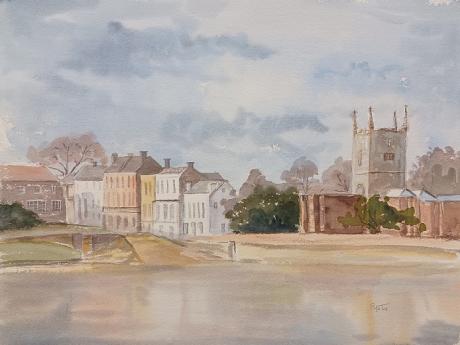" P Yates" and inscribed on the reverse
Unframed
Isleworth is a town located within the London Borough of Hounslow in West London, England. It lies immediately east of the town of Hounslow and west of the River Thames and its tributary the River Crane. Isleworth's original area of settlement, alongside the Thames, is known as 'Old Isleworth'. The north-west corner of the town, bordering on Osterley to the north and Lampton to the west, is known as 'Spring Grove'.
Isleworth's former Thames frontage of approximately one mile, excluding that of the Syon Park estate, was reduced to little over half a mile in 1994 when a borough boundary realignment was effected in order to unite the district of St Margaret's wholly within London Borough of Richmond upon Thames. As a result, most of Isleworth's riverside is that part overlooking the 8.6-acre (3.5 ha) islet of Isleworth Ait: the short-length River Crane flows into the Thames south of the Isleworth Ait, and its artificial distributary the Duke of Northumberland's River west of the Isleworth Ait, one of two Colne distributaries constructed for aesthetic reasons in the 1600–1750 period.
Much of Isleworth became orchards in the 18th century (including part of Hugh Ronalds' renowned nursery), and then market gardens in the 19th century, supplying the London markets. Lower Square and Church Street still have buildings dating from the 18th and early 19th centuries. A striking element of this period was the establishment in Isleworth of many mansions and large houses, principally for aristocrats and high achievers. This phenomenon arose owing mainly to the collection of royal and noble residences and ecclesiastical establishments that already existed nearby. The subject is examined in depth in the "Notable houses" section.
There is evidence of a Black community in Isleworth in the 18th century. This community was primarily made up of enslaved people of colour, from Africa, Asia or the Caribbean. Some of these people had fled from bondage and chose to seek their freedom in the streets of London. With very few exceptions, little is known about people of colour in 18th century London. However, as a result of contemporary sources like advertisements seeking the capture and return of runaway slaves, an insight can be gained into the lives of two people, Marina Dellap and Prince, who resided in the area in 1765.
The first half of the 20th century for Isleworth generally was characterised by a very substantial amount of artisan and white-collar residential development throughout the town, at the expense of numerous market gardens. The former western area was ceded to the town and parish of Hounslow, which was invested as a civil parish in 1927. This period also included the building of several new factories and offices, mostly towards the north-east, up to the town's eastern boundary with New Brentford. This rapid spread of building transformed the nature of Isleworth's layout in the space of just fifty years, from an agrarian pattern to an urban one.
Isleworth's former Thames frontage of approximately one mile, excluding that of the Syon estate, which is shared with Brentford, was reduced to 0.5 miles (0.80 km) in 1994 when a borough boundary realignment was ordered by the UK's Local Government Minister to add land to the district of St Margarets, Twickenham.

